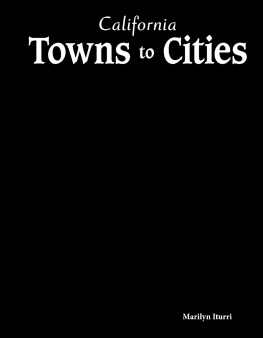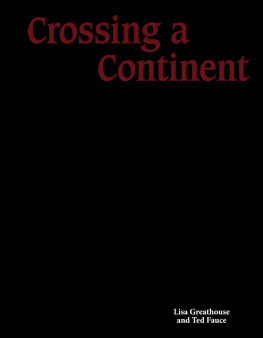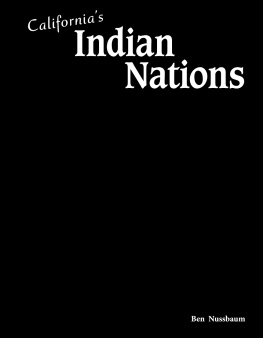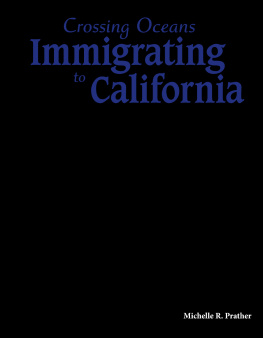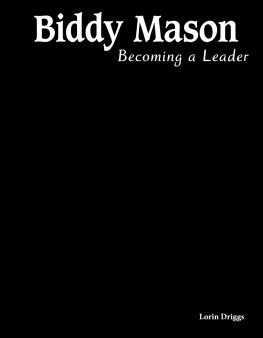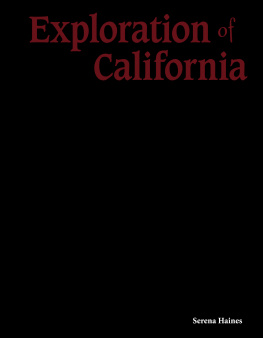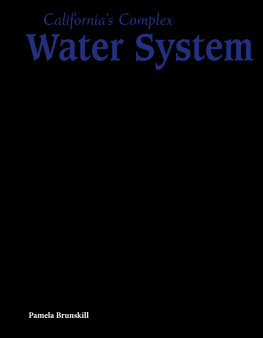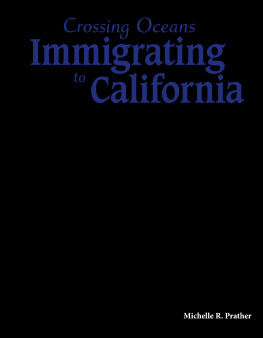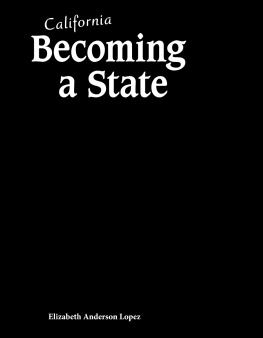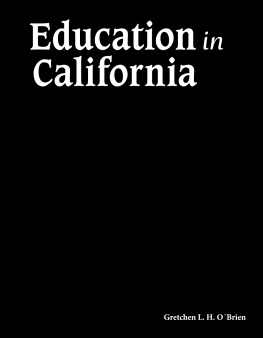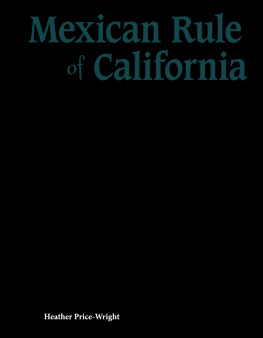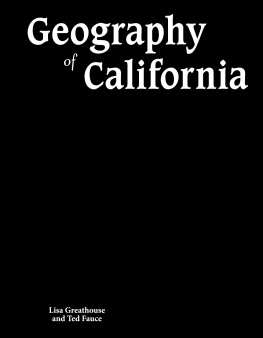Marilyn Iturri - California: Towns to Cities
Here you can read online Marilyn Iturri - California: Towns to Cities full text of the book (entire story) in english for free. Download pdf and epub, get meaning, cover and reviews about this ebook. year: 2018, publisher: Teacher Created Materials, genre: Politics. Description of the work, (preface) as well as reviews are available. Best literature library LitArk.com created for fans of good reading and offers a wide selection of genres:
Romance novel
Science fiction
Adventure
Detective
Science
History
Home and family
Prose
Art
Politics
Computer
Non-fiction
Religion
Business
Children
Humor
Choose a favorite category and find really read worthwhile books. Enjoy immersion in the world of imagination, feel the emotions of the characters or learn something new for yourself, make an fascinating discovery.
- Book:California: Towns to Cities
- Author:
- Publisher:Teacher Created Materials
- Genre:
- Year:2018
- Rating:3 / 5
- Favourites:Add to favourites
- Your mark:
- 60
- 1
- 2
- 3
- 4
- 5
California: Towns to Cities: summary, description and annotation
We offer to read an annotation, description, summary or preface (depends on what the author of the book "California: Towns to Cities" wrote himself). If you haven't found the necessary information about the book — write in the comments, we will try to find it.
California: Towns to Cities — read online for free the complete book (whole text) full work
Below is the text of the book, divided by pages. System saving the place of the last page read, allows you to conveniently read the book "California: Towns to Cities" online for free, without having to search again every time where you left off. Put a bookmark, and you can go to the page where you finished reading at any time.
Font size:
Interval:
Bookmark:
0covercover.xhtmlCalifornia Towns to Cities Marilyn Iturricover1page0001page0001.xhtml22page0002page0002.xhtml33page0003page0003.xhtml44page0004page0004.xhtmlTable of Contents Coming to California 4 City by the Bay 10 Grown from Gold 14 Finding Fresno 18 The City of Angels 22 Golden Geography 26 Describe It 28 Glossary 30 Index 31 Your Turn 3255page0005page0005.xhtmlComing to California The 1800s were a time of huge growth for California. Many people had heard tales of rivers flowing with gold. They flocked to the West hoping to get rich quick. In 1856, just seven years after it began, the Gold Rush was over. But the people who came hoping to find gold wanted to stay. They found jobs and built new lives for themselves. California kept growing. People looking for work migrated to new places. Cities formed where large groups of people gathered. The locations of the cities were based on the geography of each region. The natural features of a place shaped what people did for work. People on the coast built ports and ships. Meanwhile, people inland built railroads, farmed, and mined for gems. They were all doing their parts to make the state grow. These early settlers molded California into the powerful state it is today. Population Overload Today, almost 39 million people live in California. That's more than any other state! Most of the people live in three areas. One area is the San Francisco- Oakland Bay area. The next is Southern California. The third is the Central Valley. One of the main cities there is the state capital, Sacramento.66page0006page0006.xhtml Ring of Fire California is located within the Pacific Ring of Fire. This is an area that has active volcanoes and earthquakes. The San Andreas Fault runs up and down the state. The plates along this fault have caused some of the major earthquakes in the state. Mount Shasta and Mount Lassen are active volcanoes in the area. Wagon trains make the long journey to the West.77page0007page0007.xhtmlReasons for Immigration California's growth was due in large part to immigrants. Most of them came from Ireland, Germany, and China. Hard times at home caused each group to look to the United States for hope. In Ireland, three years of crop failures led to the Irish Potato Famine. Nearly a million people died. Almost two million people left the country. Most of them arrived in the United States poor and hungry. Germany suffered years of civil unrest. The living conditions there kept getting worse. Many Germans could not find jobs. So almost a million Germans left the country. Work was also hard to find in China. The Gold Rush was the chance at wealth the Chinese people were looking for. Hundreds of thousands of them sailed across the Pacific Ocean to find work. Immigrants all left home for their own reasons. But they came to California for the same one a chance at better lives. Chinese miners lived in their own camps during the Gold Rush.88page0008page0008.xhtml Irish in the City In 1845, Ireland's farmers watched their crops rot away in their fields. The same thing happened the next two years. The people of Ireland were in a terrible state. For many people, the choice was either to stay and starve or to leave and hope for the best. By 1880, one in three people living in San Francisco was Irish. During the Irish Potato Famine, farming families didn't have enough money for the basics. Here, they line up for free clothing. Push and Pull Factors There are two reasons people migrate : push and pull factors. A push factor is a type of problem. The problem comes from someone's home land and causes the person to leave. A pull factor is a ben efit. A person sees something positive in another place and chooses to go there. California had strong p ull factors, such as gold, rich soil, and warm weather, w hich drew people in.99page0009page0009.xhtmlWhen people came to California, many of them moved to the cities. One of the first places they started new lives was in San Francisco. People came on boats and docked at its harbor. They settled there. People lived and worked with others from their home countries. They practiced their cultural and religious customs. These communities earned new nicknames. They came to be known as Chinatowns, Germantowns, and Irishtowns. Word spread quickly about the Gold Rush. Even more people packed up and moved west. Many miners settled in Sacramento. Then the city was named the state capital. Once it was made a stop on the Transcontinental Railroad, the city grew even faster. Fresno had rich soil ideal for growing crops. People who were farmers in their home countries moved there. Their hard work soon made the Central Valley the agricultural center of the state. Los Angeles was a small town until the end of the century. Small groups moved there for the warm weather and farmland. Then, oil was found in the region. After that, people flooded the city. It is now the largest city in the state.1010page0010page0010.xhtml Great China Herb Co. For centuries, the Chinese have used herbs for preventing and treating illnesses. One family opened an herb shop in Chinatown in 1922. It's still open. The owners keep hundreds of herbs to help their customers. These healing herbs are stored in the original cupboards behind the counter. San Francisco's Chinatown in 1900 was very busy.1111page0011page0011.xhtmlCity by the Bay San Francisco was a small town in its early years. In 1848, the city was home to just 800 people. But after the discovery of gold, the population exploded. Tens of thousands of people came through its harbor. The harbor played a key role in the city's growth. Goods and supplies also arrived through the harbor. It was the world's entry into the state. As more people came, the city continued to grow. People had new ideas for how to make the city a better place. One of these ideas came from a man named Andrew Hallidie (HAH-lih-dee). He saw the city's steep hills. They made it hard to get from one part of the city to another. So, in 1873, Hallidie invented cable cars. People could move around the city more easily. Due to advances like this, San Francisco quickly grew into a huge city. The Golden Gate The San Francisco Bay flows to the Pacific Ocean through a narrow strait. The Golden Gate Strait got its name from John C. Frmont in 1846. He could picture ships full of riches coming to the city through the strait. The famous bridge with the same name opened in 1937.1212page0012page0012.xhtmlIn 1873, San Francisco's first horseless streetcar was installed. Saving Horses Hallidie's idea to build cable cars came from an awful accident. One day, he saw a group of horses struggling to pull a heavy streetcar up a hill. Then, the streetcar slid backward. It killed all of the animals. Hallidie decided to attach cars to cables to help pull them along. San Francisco harbor in 18491313page0013page0013.xhtmlAs the century was coming to a close, San Francisco was still booming. Railroad lines linked the city with the rest of the state. Then, in 1869, a huge project was finished. The Transcontinental Railroad changed the state. San Francisco saw the effects of the new railroads right away. Goods from the East could more easily be brought to the city. And the city's products could now be sent to the rest of the country. The railroads also helped new companies grow. Domingo Ghirardelli (GEER-ahr-deh-lee) first sold his candy to gold miners. People in the city loved his chocolates. After the railroad opened, he began sending his products all over the country. Levi Strauss made his first pair of jeans just years after the Gold Rush started. The idea came from seeing miners tear through their pants. The people who thrived were good at giving people what they needed. The same can be said of people in San Francisco today. Levis and Landfills Today, Levi Strauss & Co. still operates out of the Financial District in San Francisco. Like much of the city, the area is hilly, not flat. This is because San Francisco was built on a landfill. The hills in the city are actually old piles of garbage!1414page0014page0014.xhtml Pass the Salt The San Francisco Bay area has many salt ponds. For thousands of years, American Indians took salt from the water. They used it for cooking and trading. By the late nineteenth century, salt had become a huge business in California. Today, the colorful salt ponds can be seen by people in planes flying over the bay. Ghirardelli Square1515page0015page0015.xhtmlGrown from Gold Sacramento was born out of the Gold Rush. People flocked to the area after gold was found at John Sutter's mill. The mill was located at the junction of two rivers, about 50 miles (80 kilometers) east of Sacramento. Miners searched the rivers for gold. The rivers also offered a way to travel by boat. Miners needed supplies. Stores opened that sold shovels, pans, and clothing for miners. The city grew into a center for trade. That brought in more people. The Gold Rush caused many cities to grow quickly. This is what happened to Sacramento. In 1854, Sacramento was named the state's capital. Years later, the city served as the end of the western half of the Transcontinental Railroad. When the railroad was finished, it brought more people to the West. The new line also helped California farmers send food to the rest of the country. Sacramento in 18781616page0016page0016.xhtmlSutter's Mill Eagle Theatre The first theater in the state was in Sacramento. It opened in 1849. Three months after it opened, a heavy storm hit the town. The building flooded and was ruined. Today, people can visit the rebuilt Eagle Theatre and learn about the early days of the town.1717page0017page0017.xhtmlmodern-day Sacramento After the Gold Rush, farming became one of the state's biggest industries. Trains traveled through the Midwest carrying crops that were grown in California. People across the country were awed at what they saw. They could not believe that such a wide range of crops could grow in one place. Within five years, three out of four crops shipped to the East Coast came from the Sacramento Valley. In 1867, chilled railcars were invented. They opened up new markets for farmers. Even more crops from the West could be shipped to the East because they would not spoil on the way. Sacramento's mild weather and rich soil lured farmers from other states. The first decade of the twentieth century saw another mass migration to Sacramento. It was no longer a small town filled with miners. It was now a huge city, which played a key role in the growth of the state.1818page0018page0018.xhtmlJanuary 1866 edition of the Sacramento Daily Union Twain Out West Mark Twain was hired to work for the Sacramento Daily Union in 1866. This was a newspaper in Sacramento. His job was to write about what life was like in the Sandwich Islands (now Hawaii). His articles were a huge success. Because of them, his writing career took off. Twain published The Adventures of Tom Sawyer 10 years later. Washing Away Since it sits on two rivers, Sacramento flooded many times in its early days. Two floods in 1850 and 1862 destroyed much of the town. Residents used wagons to haul in loads of dirt. They raised street levels up 15 feet (4 meters). Today, the original street can still be seen under the boardwalk in the old part of town. Sacramento after the flood of 18501919page0019page0019.xhtmlFinding Fresno Fresno does not have a long past like San Francisco. The first settlers did not arrive until the 1860s. The area stayed a small town until the introduction of the railroad. After that, more people came to work the land. Before the railroad was built there, people did not think Fresno had much to offer. From afar, the land looked quite dry. Actually, the soil was fertile. But, water was hard to get. A man named Moses Church found a way to move water to the fields. His canals brought water from the region's rivers. The water gave life to the land, and the valley soon bloomed. Wheat became one of Fresno's most important crops. Even with the booming wheat trade, early attempts to start a farming society in Fresno failed. Church had solved many problems, but not all land had water. It was also difficult to get the word out that land was available. Fresno Station to Fresno City In 1872, the Central Pacific Railroad built a new railroad through the San Joaquin Valley. One of the stops was called Fresno Station. Soon, merchants followed the railroad and stayed in the city. Farmers came for work, too. By the turn of the century, the city had grown to 12, 470 people. Passengers wait for a train in Fresno in the early 1900s.2020page0020page0020.xhtml How Fresno Was Named The name Fresno is Spanish for "ash trees. " When Spanish explorers sailed along the San Joaquin River, they saw a long section of white ash trees. The sailors did not stop to search the area because they thought it had been neglected for too long. Even during the Gold Rush, miners passed through this area without stopping. This area grows many of the state's fruits, such as oranges.2121page0021page0021.xhtmlFarmers in Fresno knew water would be the key to the town's success. They turned to Moses Church for help once more. Church had started a company that sold water to farmers. The people of Fresno put their money together. They bought water rights from Church for their lands. This guaranteed that anyone who bought land in Fresno would have water for farming. In order to grow, Fresno needed more people. Farmers advertised land sales back East. They even placed advertisements about land in Fresno in Europe and Australia. Fresno's success helped the valley grow. As more railroads were built, farmers sent crops across the country. Today, crops from Fresno are shipped all over the world. The Accidental Raisin Raisins are dried grapes. Francis Eisen grew grapes on his Fresno properties. One year, many of his grapes dried on the vine. He sent the raisins to San Francisco and sold them as a "Peruvian delicacy. " Today, Fresno County is known as the "Raisin Capital of the World. " This 1901 photo shows a farm in Fresno with raisin-drying racks.2222page0022page0022.xhtmlThe goal of this advertisement was to attract people to California. Inspirational Women Minnie Austin, Lucy Hatch, E. A. Cleveland, and Julia Short were teachers. In 1878, they pooled their money to buy five lots of land in Fresno. Their land, known as the Hedgerow Vineyard, was a huge success.2323page0023page0023.xhtmlThe City of Angels Los Angeles means "the angels" in Spanish. That's how it earned its nickname "City of Angels. " Los Angeles did not burst into life during the Gold Rush. Instead, the town grew slowly until a new railroad came in 1880. Then, a price war started between the rail companies. Travelers could come to Los Angeles from the Midwest for as little as $1. So, they did. People selling land in Los Angeles thought of new ways to bring in residents. They advertised in magazines all over the country. They wrote about the region's warm weather, fertile lands, and tourist sites. Los Angeles sounded like a great place to start a new life. And it was. A man named Edward Doheny found oil in the city in 1892. This set off the state's first oil boom, and the city grew very quickly. Doheny became rich by selling oil to local industries. Soon, people were finding oil all over Los Angeles. As people found more uses for oil, the city grew. All the News The first issue of the Los Angeles Daily Times was printed in 1881. But within a year, the newspaper's founders were almost out of money. They hired a man named Harrison Gray Otis. He turned it into a huge success. Today, it is known as the Los Angeles Times.2424page0024page0024.xhtml Oranges for All Oranges used to be rare and expensive in most of the country. They grew well in Southern California. But they would rot by the time they reached other cities. Refrigerated railcars changed that. The first railcar of chilled oranges left Los Angeles in 1886. Today, oranges are the fourth most popular fruit in the world. Orange groves and oil fields could be seen close together near Los Angeles.2525page0025page0025.xhtmlAs more people came to Los Angeles, the city spread. By 1900, one in eight people in the state lived in Los Angeles County. But all this growth strained local resources. Getting fresh water quickly became a problem. When a major drought hit the city, residents knew they had to do something. In 1905, plans began for an aqueduct. It brought water to the city from the Owens River, which was 200 miles north (322 kilometers). The aqueduct took eight years to build. When it was finished, Los Angeles had four times more water than what it needed. With the water crisis solved, more people moved to the city. Los Angeles kept growing. Today, it is a giant city. In the United States, only New York City has more people. More than four million people call the City of Angels home. modern-day Los Angeles Headed West World War II ended in 1945. After the war, people came to Los Angeles in droves. The number of African Americans in the city jumped at this time. Before the war, they made up about 4 in 100 people in the city. By 1970, that number was about 25 in 100.2626page0026page0026.xhtml City Versus County Counties are made up of groups of cities. California has 58 counties. Alpine County is the smallest one in California. There are fewer than 2, 000 residents there. Los Angeles County is the biggest in the state. It is also the biggest in the whole country. There are more than 10 million people living in that county! Los Angeles in 19102727page0027page0027.xhtmlGolden Geography Geography affects how people live. It shapes why people move to an area. Many people felt the pull of California. Once there, they chose where to live based on what they wanted to do. Farmers moved to the valleys. Miners lived in the mountains. The settlement of major cities depended on where the cities were located. San Francisco formed next to the bay, where people from around the world arrived by ship. Sacramento and Fresno have rich soil to help grow crops. When the first railroad reached Los Angeles, people came to see what the southern part of the state could offer. Geography changed how the state was shaped. And it still has a huge effect on people today. California, Disney-Style In 2001, a new theme park opened. Disney California Adventure Park initially honored the history and culture of the state. There is a water ride that mimics a rafting trip in the Sierra Nevada. Red trolley cars ride around an area of the park, like the ones that people rode in Los Angeles in the 1920s. Over the years, the rides and themes have changed. But the spirit of California is still present throughout the park.2828page0028page0028.xhtml State Stats California is huge! Geographically, it is the third-largest state in the country. It covers more than 163, 000 square miles (422, 000 square kilometers). The state is about the same size as France, Iraq, and Thailand.2929page0029page0029.xhtmlDescribe It! Many brave people came to California in its early days. They came from across the country and around the world. These people left behind family and friends. The settlers left their old lives without knowing what their new lives would bring. Travel could be difficult and dangerous. Most people did not know what to expect when they arrived. But they came anyway. Imagine that you are a settler in California's early days. In which city would you choose to settle San Francisco, Sacramento, Fresno, or Los Angeles? Write a letter to your family back home telling them about your adventure. Describe a day in your life and why you decided to move to your new city.3030page0030page0030.xhtml3131page0031page0031.xhtmlGlossary agricultural relating to farming aqueduct a human-made canal that brings water from one place to another canals a passage dug across land used for transportation of water, goods, and people civil unrest a situation in which many of the people in a state or country do things to show their disagreement customs traditional behaviors or actions of a group of people delicacy a food that people like to eat because it is very rare or special droves large groups of people or animals that move together famine a situation in which many people are starving fertile capable of supporting the growth of many plants flocked moved or gathered in a crowd geography the natural features of a place, such as rivers and mountains harbor part of an area of water that is next to land and provides safety for ships ideal exactly right for a particular situation, purpose, or person immigrants people who come to a country to live there industries groups of businesses that work to provide particular products or services inland away from the coast junction the place where two things come together landfill an area where trash is buried underground lured persuaded a person or animal to go somewhere or to do something migrated moved from one country or place to another pooled put money together to make a larger amount state the overall physical condition of a person or thing3232page0032page0032.xhtmlIndex Adventures of Tom Sawyer, The, American Indians, Austin, Minnie, Central Pacific Railroad, Central Valley, China, Chinatown, Church, Moses, Cleveland, E. A., Doheny, Edward, Eagle Theatre, Frmont, John C., Fresno, Germantown, Germany, Ghirardelli, Domingo, Golden Gate Strait, Gold Rush, Hallidie, Andrew, Hatch, Lucy, Ireland, Irish Potato Famine, Irishtown, Los Angeles, Los Angeles Daily Times, Los Angeles Times, Mount Lassen, Mount Shasta, Otis, Harrison Gray, Sacramento, Sacramento Daily Union, San Andreas Fault, San Francisco, San Francisco Bay, Short, Julia, Strauss, Levi, Sutter, John, Transcontinental Railroad, Twain, Mark, World War II,3333page0033page0033.xhtmlYour Turn! Prize Posters This poster was published around 1870 by the Rand McNally & Co. It calls California the "Cornucopia of the World. " A cornucopia is a container that is full of fruits and flowers. Think about why the poster creator may have referred to California in that way. Look at the other information presented in the poster. What else could be included that might draw new people to California? Design a new poster to try to show people who live far away the benefits of living in California.3434page0034page0034.xhtmlRead and Respond 1. What are some reasons that people decided to move to California? 2. What two natural resources drew people to California? 3. How did chilled railcars help farmers in California? 4. Use a Venn diagram to compare and contrast two of the cities in this book. 5. Which city in the book do you think has had the biggest impact on California? Explain your reasons. 6. Write a song or rap about one of the towns. Include details about why people moved there and why it became bigger.3535page0035page0035.xhtmlCalifornia Towns to Cities When California became a state, people saw it as a land of wealth and opportunity. By the turn of the century, people were moving to the state by the thousands. Settlers thrived. It seemed like there was something for everyone in California. A Changing California36
Next pageFont size:
Interval:
Bookmark:
Similar books «California: Towns to Cities»
Look at similar books to California: Towns to Cities. We have selected literature similar in name and meaning in the hope of providing readers with more options to find new, interesting, not yet read works.
Discussion, reviews of the book California: Towns to Cities and just readers' own opinions. Leave your comments, write what you think about the work, its meaning or the main characters. Specify what exactly you liked and what you didn't like, and why you think so.

